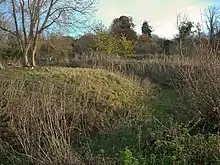Zouches Manor
Zouches Manor (also Zouches Castle) was an Anglo-Saxon moated manor in Fulbourn Fen, a Site of Special Scientific Interest in the village of Fulbourn, Cambridgeshire, England. It is one of the historic Five Manors of Fulbourn and recorded to have existed 1066 AD to 1539 AD.[1]

Creation
The eponymous manor was built by Alan la Zouche, Earl of Brittany (the same family that held Ashby-de-la-Zouch in Leicestershire) [2] in the 13th century on an earlier site. The moat ditch and platform are likely to have been constructed in the 12th or 13th century, obscuring who exactly built the structure.
It came in the hands of the Zouches in 1230, following peace with Brittany. Alan la Zouche, then viscount of Rohan, granted his Cambridgeshire lands to Roger la Zouch. The Zouches and their successors continued to hold Zouches Manor of the honor of Richmond into the 15th century in socage, rendering two gilt spurs yearly into the 15th century. After 1500 the tenure was reckoned as knight service.[3]
Dunmowes Manor
It later came into ownership by the Docwra family when it was known as Dunmowes Manor. There is ambiguity[4] over whether Zouches Manor and Dunmowes Manor are the same or whether the latter was built by the Dockra family in the 16th century on the site of the former.[5] The Dockra (or Docwra) family has extensive history in the area.[6][7][8][9][10][11][12]
Dunmowes Manor took its name from the Norman surname Dunmowe (Saxon 'Dommauua', modern English 'Dunmall'). The Domesday Book recorded the family as holders of a family seat as Lords of the Manor of Dunmow.[13] It is unclear if this is Dunmowes Manor in Fulbourn or the Essex villages 30 miles away at Great Dunmow and Little Dunmow.
Location
The location commands access to the village and the upland areas from The Fens and was probably chosen to defend against attack from the Fens during troubles such as the First Barons' War in the 13th century and the battles between the Romano-British (to the south), Anglo-Saxons (in East Anglia) and Belgae & Norman invaders.
The site has been extensively archaeologically researched.[14][15]
References
- "BRIEF FOR ARCHAEOLOGICAL EVALUATION - Cambridgeshire Historic Environment Team" (PDF). Archived from the original (PDF) on 30 March 2018.
- ""Fulbourn conservation area" - South Cambridgeshire District Council (2007)" (PDF).
- "Fulbourn: Economic history".
- "Cantab Ramblers - CANTAB76 March 2014".
- "Fulbourn - Cantab Ramblers".
- "Will of Susan Docwra, Widow of Fulbourn, Cambridgeshire". 12 December 1644.
- "1644 - Susan DOCWRA of Fulbourn, Cambs".
- "1628 - Raffe DOCWRA, of Fulbourn, Cambridgeshire".
- Docwra, Thomas. "Fulbourn Village History Society - Newsletter 36, Autumn 2012" (PDF).
- Docwra (26 September 1996). A Concise History of the University of Cambridge - Captain Docwra of Fulbourn. ISBN 9780521439787.
- Docwra, James (1635). "Proceedings of the Cambridge Antiquarian Society, with Communications Made to the Society, Volumes 60-63".
- Docwra, James (1655). Contrasting Communities: English Villages in the Sixteenth and Seventeenth Centuries. ISBN 9780521297486.
- "Dunmall History, Family Crest & Coats of Arms".
- "BRIEF FOR ARCHAEOLOGICAL EVALUATION - Cambridgeshire Historic Environment Team" (PDF). Archived from the original (PDF) on 30 March 2018.
- "Fulbourn Village History Society - Newsletter 15, Spring 2004" (PDF).